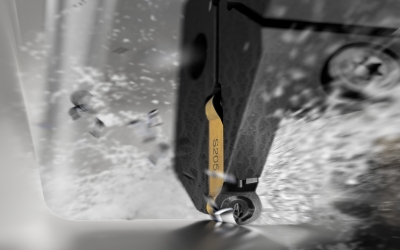
Sandvik Coromant has launched two new turning grades specifically designed for the machining of heat resistant super alloy (HRSA) materials. The S205 turning grade for finishing and semi-finishing and the Ceramic CC6165 grade for roughing to semi-finishing applications are designed for machining difficult surfaces in HRSAs.
HRSAs are typically used for aircraft parts that face extreme performance demands. Their high strength at elevated temperatures means the materials can retain their hardness when facing intense heat. The demand for lower emissions, higher fuel efficiency and power density in the transport and energy makes HRSA materials particularly valuable in these applications.
Because HRSA materials are metallurgically composed to have high strength at temperatures up to 1,000 degrees Celsius, the stresses generated when machining them are high. The unique capability of these nickel, iron and cobalt-based super alloys to perform close to the melting point of their basic metal gives them generally poor machinability.
Sandvik Coromant’s new turning grades are optimized with these machining challenges in mind. Developed for last stage machining applications in aerospace engine components, the S205 is a chemical vapour deposition (CVD) grade that offers increased productivity through higher cutting speeds in semi finishing and finishing applications.
Coated with second generation Inveio® coating for high wear resistance and long tool life, post treatment technology strengthens the S205 insert by modifying its mechanical properties. The Inveio® technology forms tightly packed uni-directional crystals around the insert to create a strong protective barrier, while delivering maximum thermal protection to improve crater wear and flank wear resistance.
Ideal for use with aged nickel-based materials and pre-machined surfaces, for machining components such as aircraft engine turbine discs, rings and shafts, the S205 boasts 30 to 50% higher cutting speeds than competing HRSA turning grades without compromising tool life.
The qualities of the CC6165 turning grade also offer superior resistance. Made from SiAION ceramic, a specialist class of high-temperature refractory materials with high strength at high temperature, the CC6165 is optimized for roughing and intermediate stage machining HRSAs as well as for profile and general turning applications.
Similar to the S205, typical components machined with the CC6165 are turbine discs, casings rings and valves.
Following its predecessor, the CC6160 turning grade from Sandvik Coromant, the CC6165 has improved edge line toughness for secure machining of more demanding HRSA surfaces. It also allows for higher metal removal rates, helping to increase productivity and reduce the cost per component.
“While the CC6160 grade is the first choice for roughing to semi-finishing of pre-machined HRSAs in stable conditions, the new CC6165 is able to meet the demands of more difficult to machine surfaces,” explained Rolf Olofsson, Product Manager at Sandvik Coromant.
“The CC6165 and the S205 have been developed to help machinists overcome the difficulties of HRSAs, so they can make the most out of the materials’ unique benefits. In fact, analysis has demonstrated a 210% increase in tool life when using the S205 to machine an aged Inconel test bar, compared to results from a competing tool.”
The introduction assortment of the S205 includes 36 items, with more to be added in spring of 2021. The Ceramic CC6165 grade is also available in a range of assortments to meet the demands of varied industries and materials.
Contact Details
Related Glossary Terms
- alloys
alloys
Substances having metallic properties and being composed of two or more chemical elements of which at least one is a metal.
- flank wear
flank wear
Reduction in clearance on the tool’s flank caused by contact with the workpiece. Ultimately causes tool failure.
- hardness
hardness
Hardness is a measure of the resistance of a material to surface indentation or abrasion. There is no absolute scale for hardness. In order to express hardness quantitatively, each type of test has its own scale, which defines hardness. Indentation hardness obtained through static methods is measured by Brinell, Rockwell, Vickers and Knoop tests. Hardness without indentation is measured by a dynamic method, known as the Scleroscope test.
- machinability
machinability
The relative ease of machining metals and alloys.
- mechanical properties
mechanical properties
Properties of a material that reveal its elastic and inelastic behavior when force is applied, thereby indicating its suitability for mechanical applications; for example, modulus of elasticity, tensile strength, elongation, hardness and fatigue limit.
- turning
turning
Workpiece is held in a chuck, mounted on a face plate or secured between centers and rotated while a cutting tool, normally a single-point tool, is fed into it along its periphery or across its end or face. Takes the form of straight turning (cutting along the periphery of the workpiece); taper turning (creating a taper); step turning (turning different-size diameters on the same work); chamfering (beveling an edge or shoulder); facing (cutting on an end); turning threads (usually external but can be internal); roughing (high-volume metal removal); and finishing (final light cuts). Performed on lathes, turning centers, chucking machines, automatic screw machines and similar machines.
- wear resistance
wear resistance
Ability of the tool to withstand stresses that cause it to wear during cutting; an attribute linked to alloy composition, base material, thermal conditions, type of tooling and operation and other variables.








